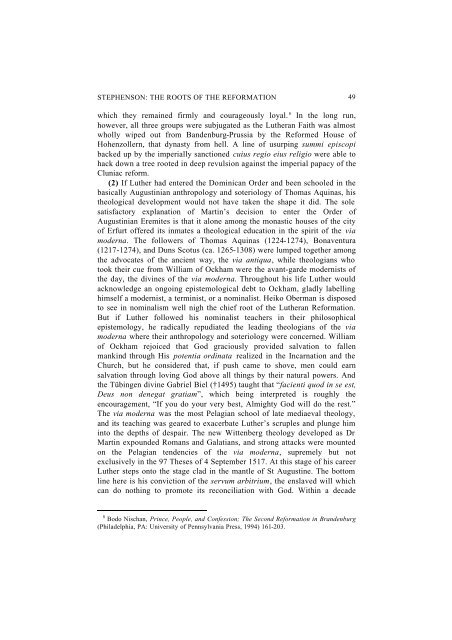LUTHERAN THEOLOGICAL REVIEW - Concordia Lutheran Seminary
LUTHERAN THEOLOGICAL REVIEW - Concordia Lutheran Seminary
LUTHERAN THEOLOGICAL REVIEW - Concordia Lutheran Seminary
Create successful ePaper yourself
Turn your PDF publications into a flip-book with our unique Google optimized e-Paper software.
STEPHENSON: THE ROOTS OF THE REFORMATION 49<br />
which they remained firmly and courageously loyal. 8 In the long run,<br />
however, all three groups were subjugated as the <strong>Lutheran</strong> Faith was almost<br />
wholly wiped out from Bandenburg-Prussia by the Reformed House of<br />
Hohenzollern, that dynasty from hell. A line of usurping summi episcopi<br />
backed up by the imperially sanctioned cuius regio eius religio were able to<br />
hack down a tree rooted in deep revulsion against the imperial papacy of the<br />
Cluniac reform.<br />
(2) If Luther had entered the Dominican Order and been schooled in the<br />
basically Augustinian anthropology and soteriology of Thomas Aquinas, his<br />
theological development would not have taken the shape it did. The sole<br />
satisfactory explanation of Martin’s decision to enter the Order of<br />
Augustinian Eremites is that it alone among the monastic houses of the city<br />
of Erfurt offered its inmates a theological education in the spirit of the via<br />
moderna. The followers of Thomas Aquinas (1224-1274), Bonaventura<br />
(1217-1274), and Duns Scotus (ca. 1265-1308) were lumped together among<br />
the advocates of the ancient way, the via antiqua, while theologians who<br />
took their cue from William of Ockham were the avant-garde modernists of<br />
the day, the divines of the via moderna. Throughout his life Luther would<br />
acknowledge an ongoing epistemological debt to Ockham, gladly labelling<br />
himself a modernist, a terminist, or a nominalist. Heiko Oberman is disposed<br />
to see in nominalism well nigh the chief root of the <strong>Lutheran</strong> Reformation.<br />
But if Luther followed his nominalist teachers in their philosophical<br />
epistemology, he radically repudiated the leading theologians of the via<br />
moderna where their anthropology and soteriology were concerned. William<br />
of Ockham rejoiced that God graciously provided salvation to fallen<br />
mankind through His potentia ordinata realized in the Incarnation and the<br />
Church, but he considered that, if push came to shove, men could earn<br />
salvation through loving God above all things by their natural powers. And<br />
the Tübingen divine Gabriel Biel (†1495) taught that “facienti quod in se est,<br />
Deus non denegat gratiam”, which being interpreted is roughly the<br />
encouragement, “If you do your very best, Almighty God will do the rest.”<br />
The via moderna was the most Pelagian school of late mediaeval theology,<br />
and its teaching was geared to exacerbate Luther’s scruples and plunge him<br />
into the depths of despair. The new Wittenberg theology developed as Dr<br />
Martin expounded Romans and Galatians, and strong attacks were mounted<br />
on the Pelagian tendencies of the via moderna, supremely but not<br />
exclusively in the 97 Theses of 4 September 1517. At this stage of his career<br />
Luther steps onto the stage clad in the mantle of St Augustine. The bottom<br />
line here is his conviction of the servum arbitrium, the enslaved will which<br />
can do nothing to promote its reconciliation with God. Within a decade<br />
8 Bodo Nischan, Prince, People, and Confession; The Second Reformation in Brandenburg<br />
(Philadelphia, PA: University of Pennsylvania Press, 1994) 161-203.













